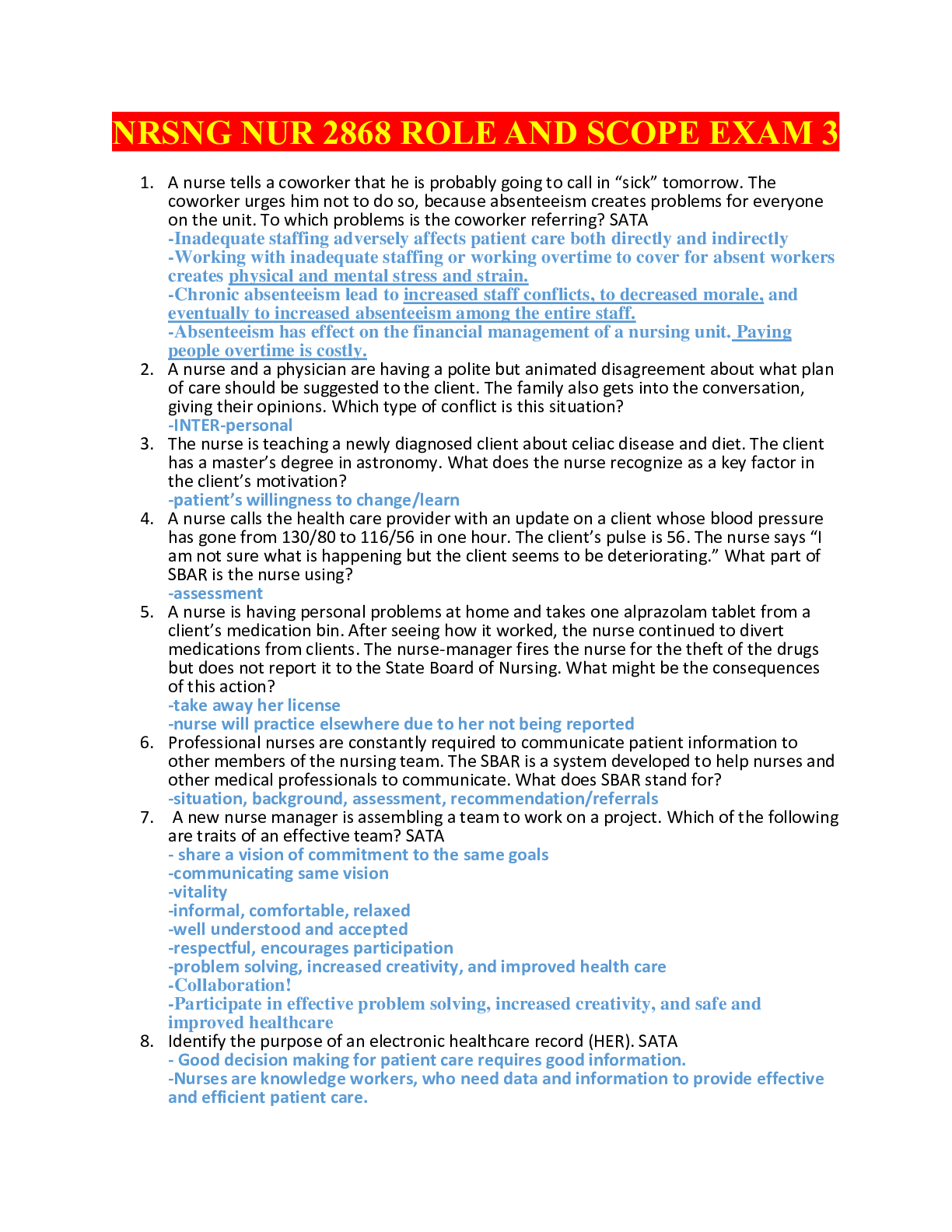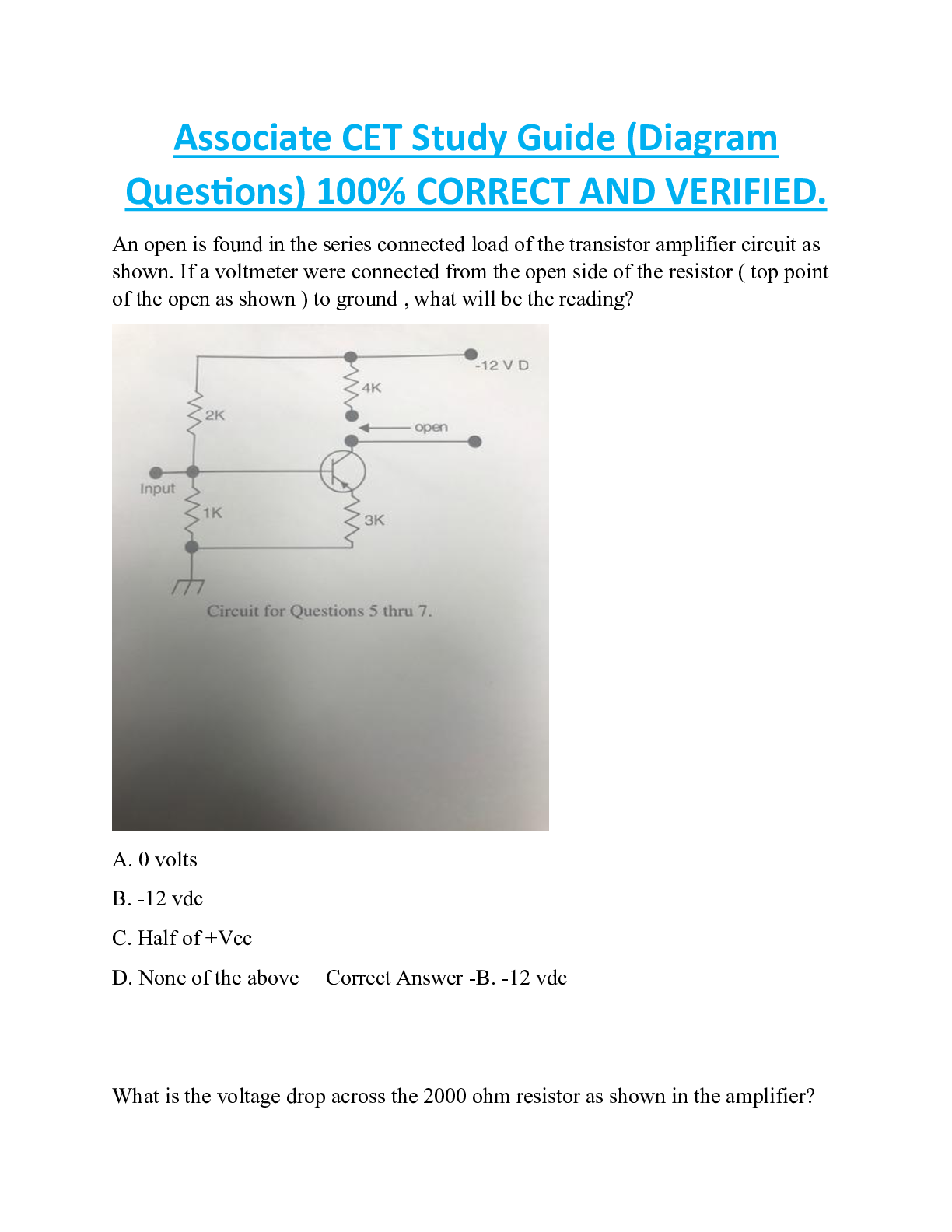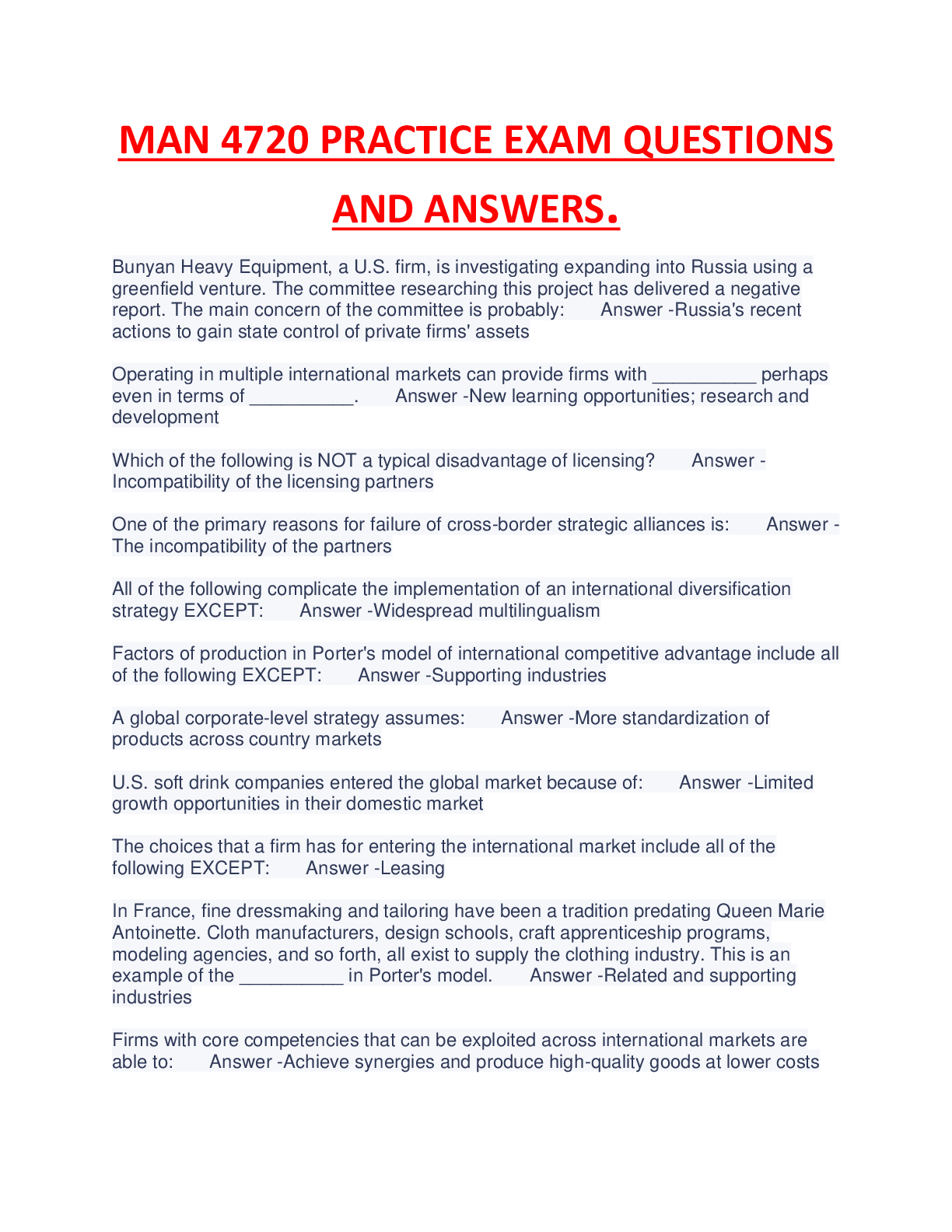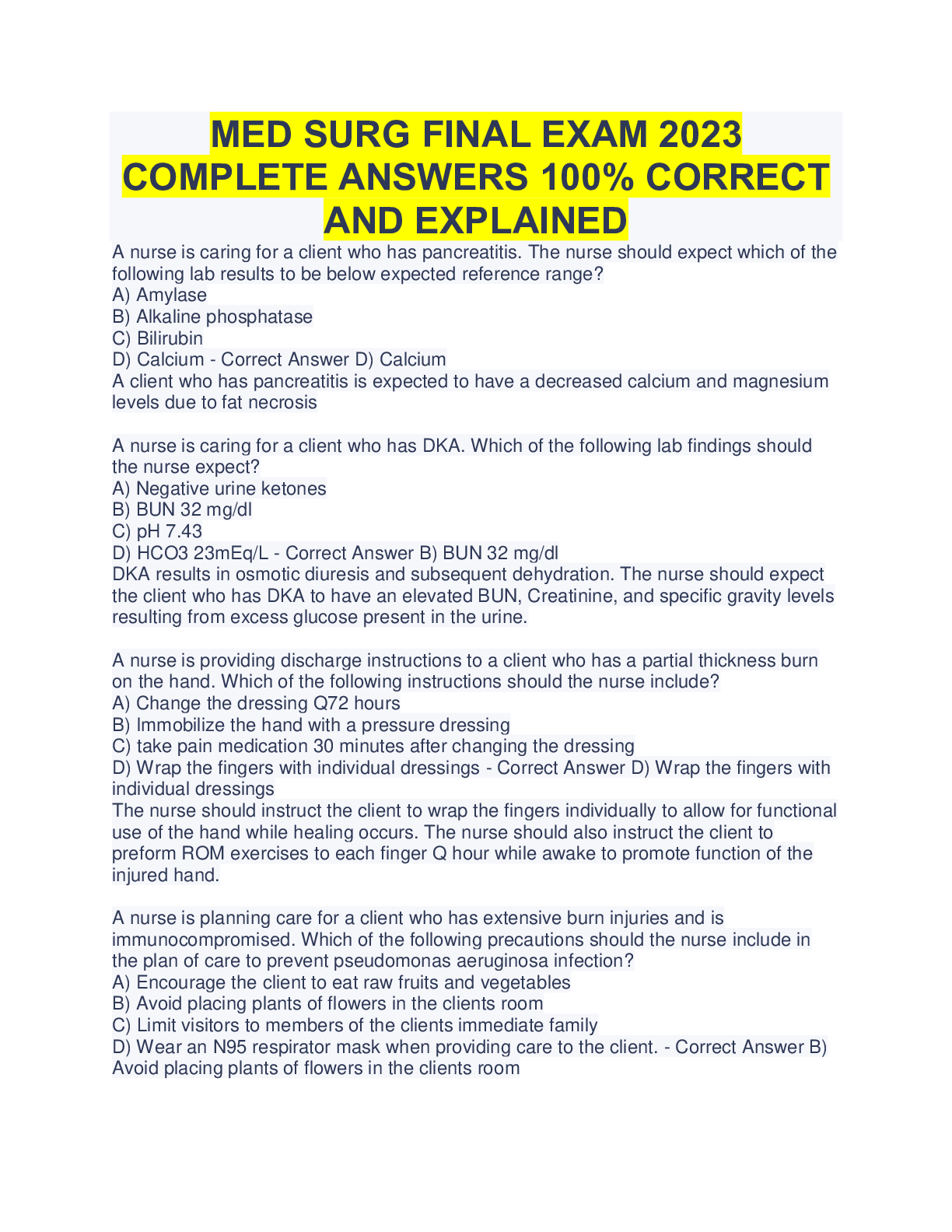Health Care > EXAM > NR 602 / NR602 MIDTERM EXAM 2022 – 100% CORRECT AND VERIFIED (All)
NR 602 / NR602 MIDTERM EXAM 2022 – 100% CORRECT AND VERIFIED
Document Content and Description Below
Chalazion Chalazion is a chronic sterile inflammation of the eyelid resulting from a lipogranuloma of the meibomian glands that line the posterior margins of the eyelids (see Fig. 29-7). It is d... eeper in the eyelid tissue than a hordeolum and may result from an internal hordeolum or retained lipid granular secretions. Clinical Findings Initially, mild erythema and slight swelling of the involved eyelid are seen. After a few days the inflammation resolves, and a slow growing, round, nonpigmented, painless (key finding) mass remains. It may persist for a long time and is a commonly acquired lid lesion seen in children (see Fig. 29-7). 727 Management • Acute lesions are treated with hot compresses. • Refer to an ophthalmologist for surgical incision or topical intralesional corticosteroid injections if the condition is unresolved or if the lesion causes cosmetic concerns. A chalazion can distort vision by causing astigmatism as a result of pressure on the orbit. Complications Recurrence is common. Fragile, vascular granulation tissue called pyogenic granuloma that enlarges and bleeds rapidly can occur if a chalazion breaks through the conjunctival surface. Blepharitis Blepharitis is an acute or chronic inflammation of the eyelash follicles or meibomian sebaceous glands of the eyelids (or both). It is usually bilateral. There may be a history of contact lens wear or physical contact with another symptomatic person. It is commonly caused by contaminated makeup or contact lens solution. Poor hygiene, tear deficiency, rosacea, and seborrheic dermatitis of the scalp and face are also possible etiologic factors. The ulcerative form of blepharitis is usually caused by S. aureus. Nonulcerative blepharitis is occasionally seen in children with psoriasis, seborrhea, eczema, allergies, lice infestation, or in children with trisomy 21. Clinical Findings • Swelling and erythema of the eyelid margins and palpebral conjunctiva 726 • Flaky, scaly debris over eyelid margins on awakening; presence of lice • Gritty, burning feeling in eyes • Mild bulbar conjunctival injection • Ulcerative form: Hard scales at the base of the lashes (if the crust is removed, ulceration is seen at the hair follicles, the lashes fall out, and an associated conjunctivitis is present) Differential Diagnosis Pediculosis of the eyelashes. Management Explain to the patient that this may be chronic or relapsing. Instructions for the patient include: • Scrub the eyelashes and eyelids with a cotton-tipped applicator containing a weak (50%) solution of no-tears shampoo to maintain proper hygiene and debride the scales. • Use warm compresses for 5 to 10 minutes at a time two to four times a day and wipe away lid debris. • At times antistaphylococcal antibiotic (e.g., erythromycin 0.5% ophthalmic ointment) is used until symptoms subside and for at least 1 week thereafter. Ointment is preferable to eye drops because of increased duration of contact with the ocular tissue. Azithromycin 1% ophthalmic solution for 4 weeks may also be used (Shtein, 2014). • Treat associated seborrhea, psoriasis, eczema, or allergies as indicated. • Remove contact lenses and wear eyeglasses for the duration of the treatment period. Sterilize or clean lenses before reinserting. • Purchase new eye makeup; minimize use of mascara and eyeliner. • Use artificial tears for patients with inadequate tear pools. Chronic staphylococcal blepharitis and meibomian keratoconjunctivitis respond to oral erythromycin. Doxycycline, tetracycline, or minocycline can be used chronically in children older than 8 years old. Acute Otitis Media AOM is an acute infection of the middle ear (Fig. 30-4). The AAP Clinical Practice Guideline requires the presence of the following three components to diagnose AOM ( Lieberthal et al, 2013): • Recent, abrupt onset of signs and symptoms of middle ear inflammation and effusion (ear pain, irritability, otorrhea, and/or fever) • MEE as confirmed by bulging TM, limited or absent mobility by pneumatic otoscopy, air-fluid level behind TM, and/or otorrhea • Signs and symptoms of middle ear inflammation as confirmed by distinct erythema of the TM or onset of ear pain (holding, tugging, rubbing of the ear in a nonverbal manner) Characteristics of different types of AOM are defined in Table 30-4. AOM often follows eustachian tube dysfunction (ETD). Common causes of ETD include upper respiratory infections, allergies, and ETS. ETD leads to 746functional eustachian tube obstruction and inflammation that decreases the protective ciliary action in the eustachian tube. When the eustachian tube is obstructed, negative pressure develops as air is absorbed in the middle ear (see Fig. 30-4). The negative pressure pulls fluid from the mucosal lining and causes an accumulation of sterile fluid. Bacteria pulled in from the eustachian tube lead to the accumulation of purulent fluid. Young children have shorter, more horizontal and more flaccid eustachian tubes that are easily disrupted by viruses, which predisposes them to AOM. Respiratory syncytial virus and influenza are two of the viruses most responsible for the increase in the incidence of AOM seen from January to April. Other risk factors associated with AOM are listed in Boxes 30-1 and 30-2. S. pneumoniae, nontypeable Haemophilus influenzae, Moraxella catarrhalis, and S. pyogenes (group A streptococci) are the most common infecting organisms in AOM (Conover, 2013). S. pneumoniaecontinues to be the most common bacteria responsible for AOM. The strains of S. pneumoniae in the heptavalent pneumococcal conjugate vaccine (PCV7) have virtually disappeared from the middle ear fluid of children with AOM ( Lieberthal et al, 2013). With the introduction of the 13-valent S. pneumoniae vaccine, the bacteriology of the middle ear is likely to continue to evolve. Bullous myringitis is almost always caused by S. pneumonia. Nontypeable H. influenza remains a common cause of AOM. It is the most common cause of bilateral otitis media, severe inflammation of the TM, and otitis-conjunctivitis syndrome. M. catarrhalis obtained from the nasopharynx has become increasingly more beta-lactamase positive, but the high rate of clinical resolution in children with AOM from M. catarrhalis makes amoxicillin a good choice for initial therapy ( Lieberthal et al, 2013). M. catarrhalis rarely causes invasive disease. S. pyogenes is responsible for AOM in older children, is responsible for more TM ruptures, and is more likely to cause mastoiditis. Although a virus is usually the initial causative factor in AOM, strict diagnostic criteria, careful specimen handling, and sensitive microbiologic techniques have shown that the majority of AOM is caused by bacteria or bacteria and virus together ( Lieberthal et al, 2013). Clinical Findings History Rapid onset of signs and symptoms: • Ear pain with possible ear pulling in the infant; may interfere with activity and/or sleep • Irritability in an infant or toddler • Otorrhea • Fever Other key factors or symptoms: • Prematurity • Craniofacial anomalies or congenital syndromes associated with craniofacial anomalies • Exposure to risk factors • Disrupted sleep or inability to sleep • Lethargy, dizziness, tinnitus, and unsteady gait • Diarrhea and vomiting • Sudden hearing loss • Stuffy nose, rhinorrhea, and sneezing • Rare facial palsy and ataxia Physical Examination • Presence of MEE, confirmed by pneumatic otoscopy, tympanometry, or acoustic reflectometry, as evidenced by: • Bulging TM (see Fig. 30-4) • Decreased translucency of TM • Absent or decreased mobility of the TM • Air-fluid level behind the TM • Otorrhea 747 • Signs and symptoms of middle ear inflammation indicated by either: • Erythema of the TM (Amber is usually seen in otitis media with effusion [OME]; white or yellow may be seen in either AOM or OME [Shaikh et al, 2010].) or • Distinct otalgia that interferes with normal activity or sleep • In addition, the following TM findings may be present: • Increased vascularity with obscured or absent landmarks (see Fig. 30-4). • Red, yellow, or purple TM (Redness alone should not be used to diagnose AOM, especially in a crying child.) • Thin-walled, sagging bullae filled with straw-colored fluid seen with bullous myringitis Diagnostic Studies Pneumatic otoscopy is the simplest and most efficient way to diagnose AOM. Tympanometry reflects effusion (type B pattern). Tympanocentesis to identify the infecting organism is helpful in the treatment of infants younger than 2 months old. In older infants and children, tympanocentesis is rarely done and is useful only if the patient is toxic or immunocompromised or in the presence of resistant infection or acute pain from bullous myringitis. If a tympanocentesis is warranted, refer the patient to an otolaryngologist for this procedure. Differential Diagnosis OME, mastoiditis, dental abscess, sinusitis, lymphadenitis, parotitis, peritonsillar abscess, trauma, ETD, impacted teeth, temporomandibular joint dysfunction, and immune deficiency are differential diagnoses. Any infant 2 months old or younger with AOM should be evaluated for fever without focus and not just treated for an ear infection. Management Many changes have been made in the treatment of AOM because of the increasing rate of antibiotic-resistant bacteria related to the injudicious use of antibiotics. Ample evidence has been presented that symptom management may be all that is required in children with MEE without other symptoms of AOM (Lieberthal et al, 2013). Treatment guidelines are decided based on the child's age, illness severity, and the certainty of diagnosis. Table 30-5 shows the recommendation for the diagnosis and subsequent treatment of AOM. 1. Pain management is the first principle of treatment. • Weight-appropriate doses of ibuprofen or acetaminophen should be encouraged to decrease discomfort and fever. • Topical analgesics, such as benzocaine or antipyrine/benzocaine otic preparations, can be added to systemic pain management if the TM is known to be intact. Topical analgesics should not be used alone. • Distraction, oil application, or external use of heat or cold may be of some use. 2. Antibiotics are also effective. (Table 30-6 lists dosage recommendations.) • Amoxicillin remains the first-line antibiotic for AOM if there has not been a previous treated AOM in the previous 30 days, there is no conjunctivitis, and no penicillin allergy (Lieberthal et al, 2013). Beta-lactam coverage (amoxicillin/clavulanate, thirdgeneration cephalosporin) is recommended when the child has been treated with amoxicillin in the previous 30 days, there is an allergy to penicillin, and the child has concurrent conjunctivitis or has recurrent otitis that has not responded to amoxicillin. If there is a documented hypersensitivity reaction to amoxicillin, the following antibiotics are acceptable, follow the non-type 1 hypersensitivity and type 1 hypersensitivity recommendations in Table 30-6: • Ceftriaxone may be effective for the vomiting child, the child unable to tolerate oral medications, or the child who has failed amoxicillin/clavulanate. 748 • Clindamycin may be considered for ceftriaxone failure but should only be used if susceptibilities are known. • Prophylactic antibiotics for chronic or recurrent AOM are not recommended. 3. Observation or “watchful waiting” for 48 to 72 hours (see Table 30-5) allows the patient to improve without antibiotic treatment. Pain relief should be provided, and a means of follow-up must be in place. Options for follow-up include: • Parent-initiated visit or phone call for worsening or no improvement • Scheduled follow-up appointment • Routine follow-up phone call • Given a prescription to be started if the child's symptoms do not improve or if they worsen in 48 to 72 hours (Table 30-7) • Communication with the parent, reevaluation, and the ability to obtain medication must be in place. 4. Recommendations for follow-up include: • After 48 to 72 hours if a child has not showed improvement in ear symptomatology, the child should be seen to confirm or exclude the presence of AOM. If the initial management option was an antibacterial agent, the agent should be changed. Prevention and Education The following interventions, shown to be helpful in preventing AOM, should be encouraged: • Exclusive breastfeeding until at least 6 months of age seems to be protective against AOM • Avoid bottle propping, feeding infants lying down, and passive smoke exposure • Avoid the use of pacifiers: Although the relationship cannot be fully explained, multiple studies have shown that pacifier use increases the incidence of AOM ( Lieberthal et al, 2013). • Pneumococcal vaccine; specifically PCV13, which contains subtype 19A • Annual influenza vaccine may help prevent otitis media 750 • Xylitol liquid or chewing gum as tolerated • Choose licensed day care facilities with fewer children • Educate regarding the problem of drug-resistant bacteria and the need to avoid the use of antibiotics unless absolutely necessary; if antibiotics are used, the child needs to complete the entire course of the prescription and follow up if symptoms do not resolve Conjunctivitis An estimated 6 million cases of bacterial conjunctivitis occur in the United States annually, at an estimated cost of $377 million to $857 million (Azari and Barney, 2013). Conjunctivitis is an inflammation of the palpebral and occasionally the bulbar conjunctiva (Fig. 29-5). It is the most frequently seen ocular disorder in pediatric practice. In pediatric patients, bacteria are the most common cause of infection (50% to 75%) most commonly from December to April. Pathogens include H. influenzae, Streptococcus pneumoniae, and Moraxella species with both gram-negative and gram-positive organisms implicated (Azari and Barney, 2013). Conjunctivitis also occurs as a viral or fungal infection or as a response to allergens or chemical irritants. Bacterial conjunctivitis is often unilateral, whereas viral conjunctivitis is most often bilateral. Unilateral disease can also suggest a toxic, chemical, mechanical, or lacrimal cause. Blockage of the tear drainage system (e.g., from meibomianitis or blepharitis), injury, foreign body, abrasion or ulcers, keratitis, iritis, herpes simplex virus (HSV), and infantile glaucoma are other known causes. Patient age is a major indicator of etiology (Table 29-6). Types of Conjunctivitis Type Incidence/Etiology Clinical Findings Diagnosis Management* Ophthalmia neonatorum Neonates: Chlamydia trachomatis, Staphylococcus aureus, Neisseria gonorrhoeae, HSV (silver nitrate reaction occurs in 10% of neonates) Erythema, chemosis, purulent exudate with N. gonorrhoeae; clear to mucoid exudate with chlamydia Culture (ELISA, PCR), Gram stain, R/O N. gonorrhoeae,chlamydia Saline irrigation to eyes until exudate gone; follow with erythromycin ointment For N. gonorrhoeae:ceftriaxone or IM or IV For chlamydia: erythromycin or possibly azithromycin PO For HSV: antivirals IV or PO Bacterial conjunctivitis In neonates 5 to 14 days old, preschoolers, and sexually active teens: Haemophilus influenzae(nontypeable), Streptococcus pneumoniae, S. aureus, N. gonorrhoeae Erythema, chemosis, itching, burning, mucopurulent exudate, matter in eyelashes; ↑ in winter Cultures (required in neonate); Gram stain (optional); chocolate agar (for N. gonorrhoeae) R/O pharyngitis, N. gonorrhoeae, AOM, URI, seborrhea Neonates: Erythromycin 0.5% ophthalmic ointment ≥1 year old: Fourthgeneration fluoroquinolone For concurrent AOM: Treat accordingly for AOM Warm soaks to eyes three times a day until clear No sharing towels, pillows No school until treatment begins Chronic bacterial conjunctivitis (unresponsive conjunctivitis previously School-age children and teens: Bacteria, viruses, C. trachomatis Same as above; foreign body sensation Cultures, Gram stain; R/O dacryostenosis, blepharitis, corneal ulcers, trachoma Depends on prior treatment, laboratory results, and differential diagnoses Review compliance and prior drug choices of conjunctivitis treatment Type Incidence/Etiology Clinical Findings Diagnosis Management* treated as bacterial in etiology) Consult with ophthalmologist Inclusion conjunctivitis Neonates 5 to 14 days old and sexually active teens: C. trachomatis Erythema, chemosis, clear or mucoid exudate, palpebral follicles Cultures (ELISA, PCR), R/O sexual activity Neonates: Erythromycin or azithromycin PO Adolescents: Doxycycline, azithromycin, EES, erythromycin base, levofloxacin PO Viral conjunctivitis Adenovirus 3, 4, 7; HSV, herpes zoster, varicella Erythema, chemosis, tearing (bilateral); HSV and herpes zoster: unilateral with photophobia, fever; zoster: nose lesion; spring and fall Cultures, R/O corneal infiltration Refer to ophthalmologist if HSV or photophobia present Cool compresses three or four times a day Allergic and vernal conjunctivitis Atopy sufferers, seasonal Stringy, mucoid exudate, swollen eyelids and conjunctivae, itching (key finding), tearing, palpebral follicles, headache, rhinitis Eosinophils in conjunctival scrapings Naphazoline/pheniramine, naphazoline/antazoline ophthalmic solution (see text) Mast cell stabilizer (see text) Refer to allergist if needed Otitis Externa Otitis externa (OE), commonly called swimmer's ear, is a diffuse inflammation of the EAC and can involve the pinna or TM. Inflammation is evidenced as (1) simple infection with edema, discharge, and erythema; (2) furuncles or small abscesses that form in hair follicles; or (3) impetigo or infection of the superficial layers of the epidermis. OE can also be classified as mycotic otitis externa, caused by fungus, or as chronic external otitis, a diffuse low-grade infection of the EAC. Severe infection or systemic infection can be seen in children who have diabetes mellitus, are immunocompromised, or have received head and neck irradiation. OE results when the protective barriers in the EAC are damaged by mechanical or chemical mechanisms. OE is most frequently caused by retained moisture in the EAC, which changes the usually acidic environment to a neutral or basic environment, thereby promoting bacterial or fungal growth. Chlorine in swimming pools adds to the 743problem because it kills the normal ear flora, allowing the growth of pathogens. Regular cleaning of the EAC removes cerumen, which is an important barrier to water and infection. Soapy deposits, [Show More]
Last updated: 1 year ago
Preview 1 out of 60 pages
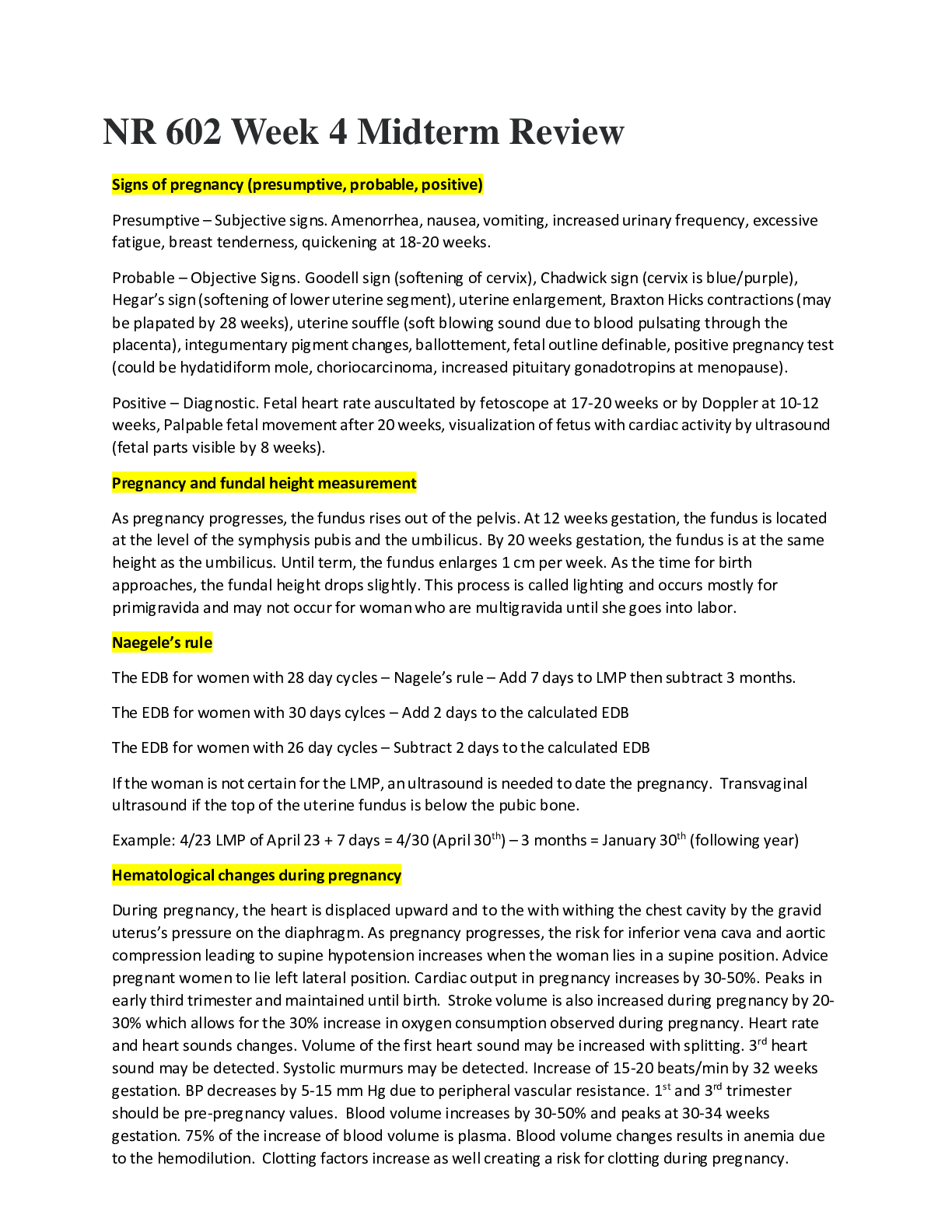
Reviews( 0 )
Document information
Connected school, study & course
About the document
Uploaded On
Jul 29, 2022
Number of pages
60
Written in
Additional information
This document has been written for:
Uploaded
Jul 29, 2022
Downloads
0
Views
48


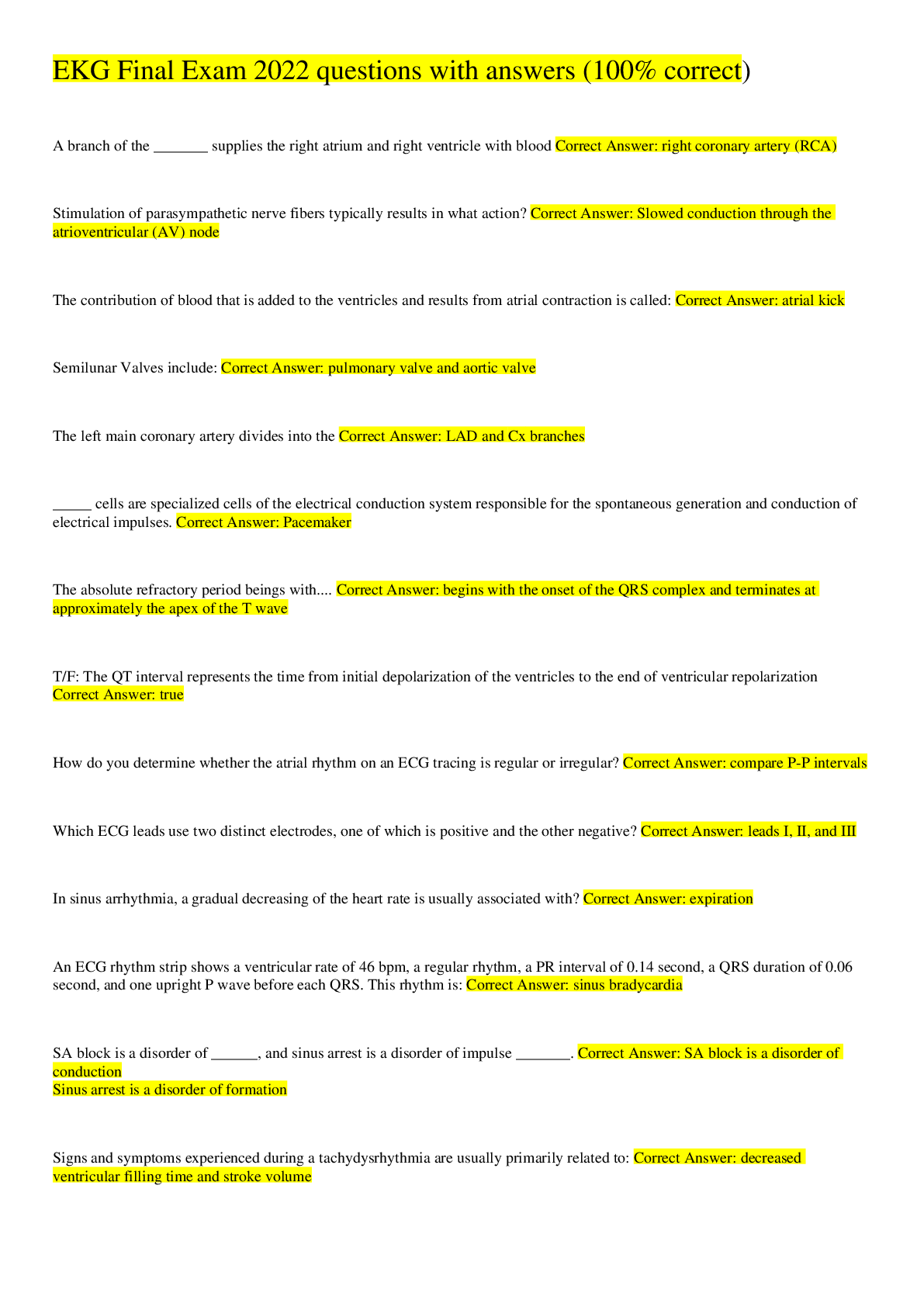
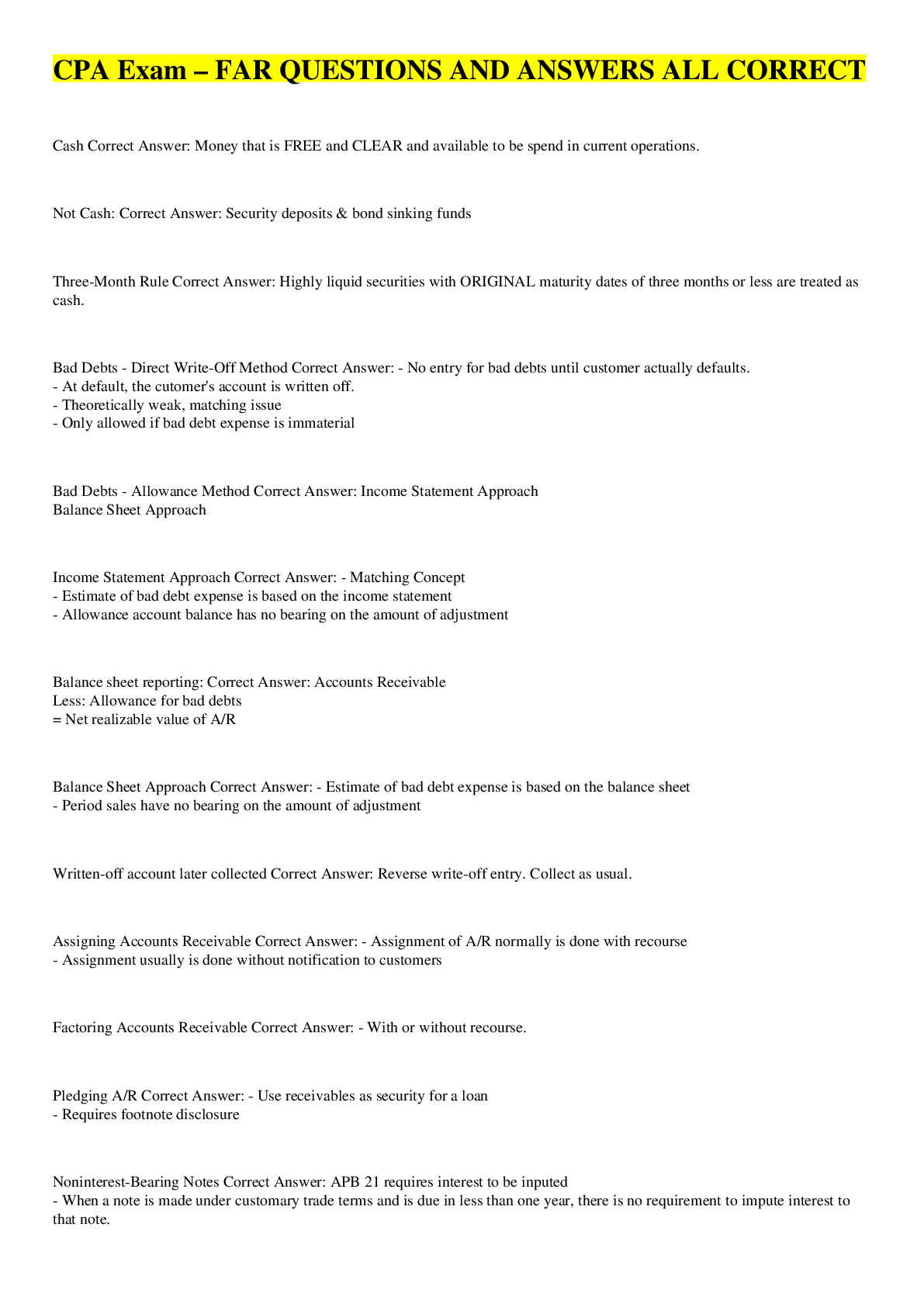
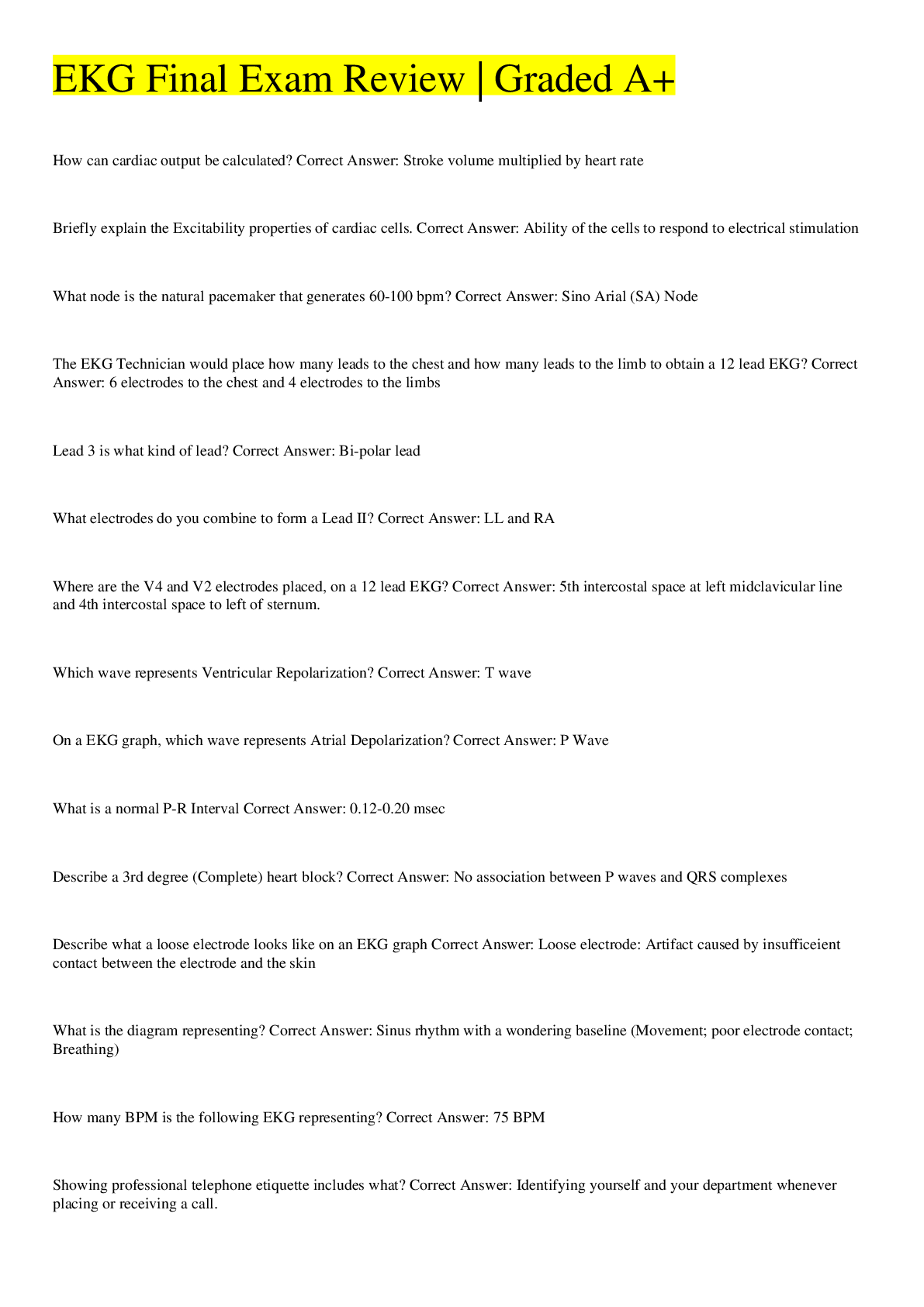
.png)

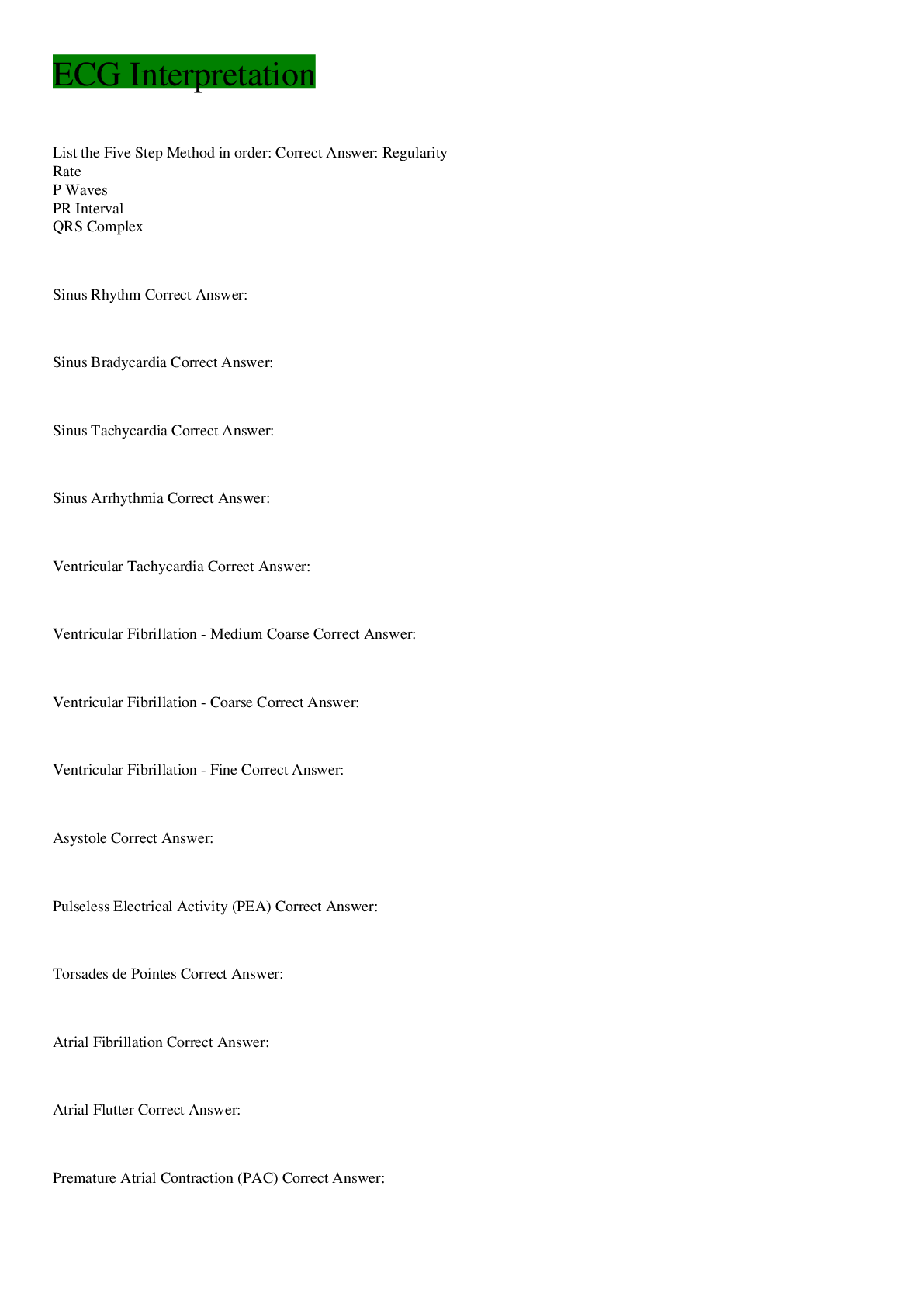


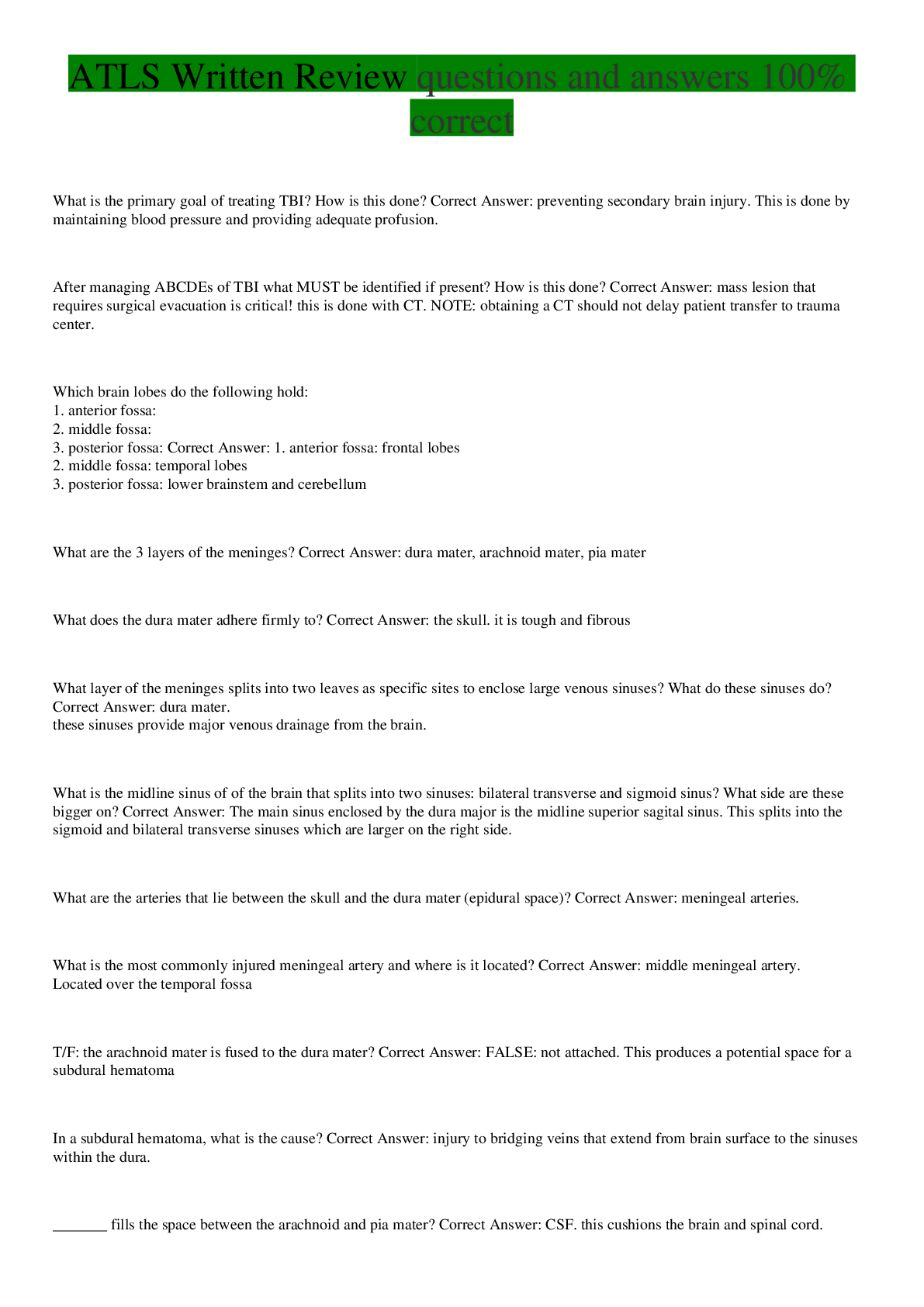
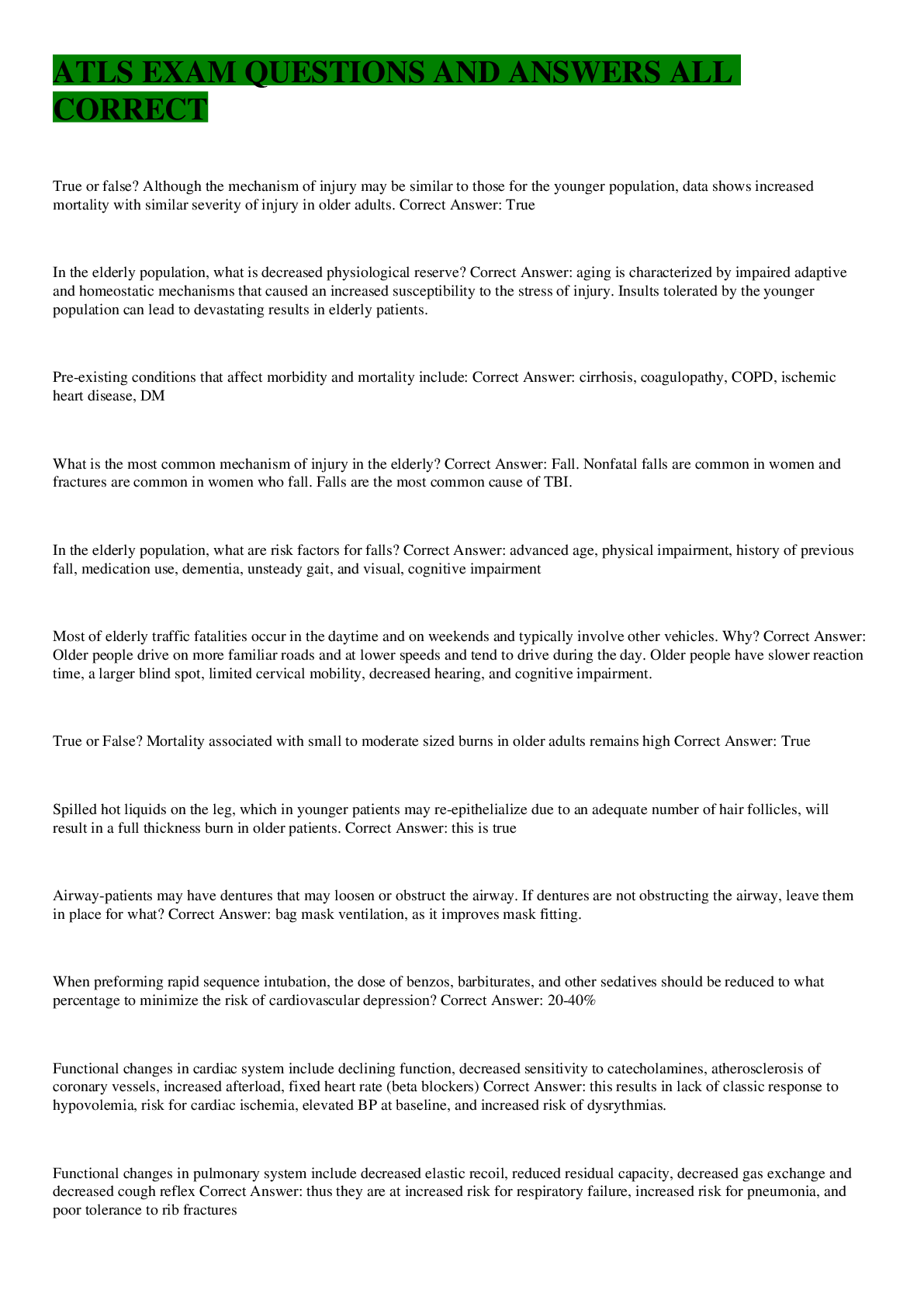


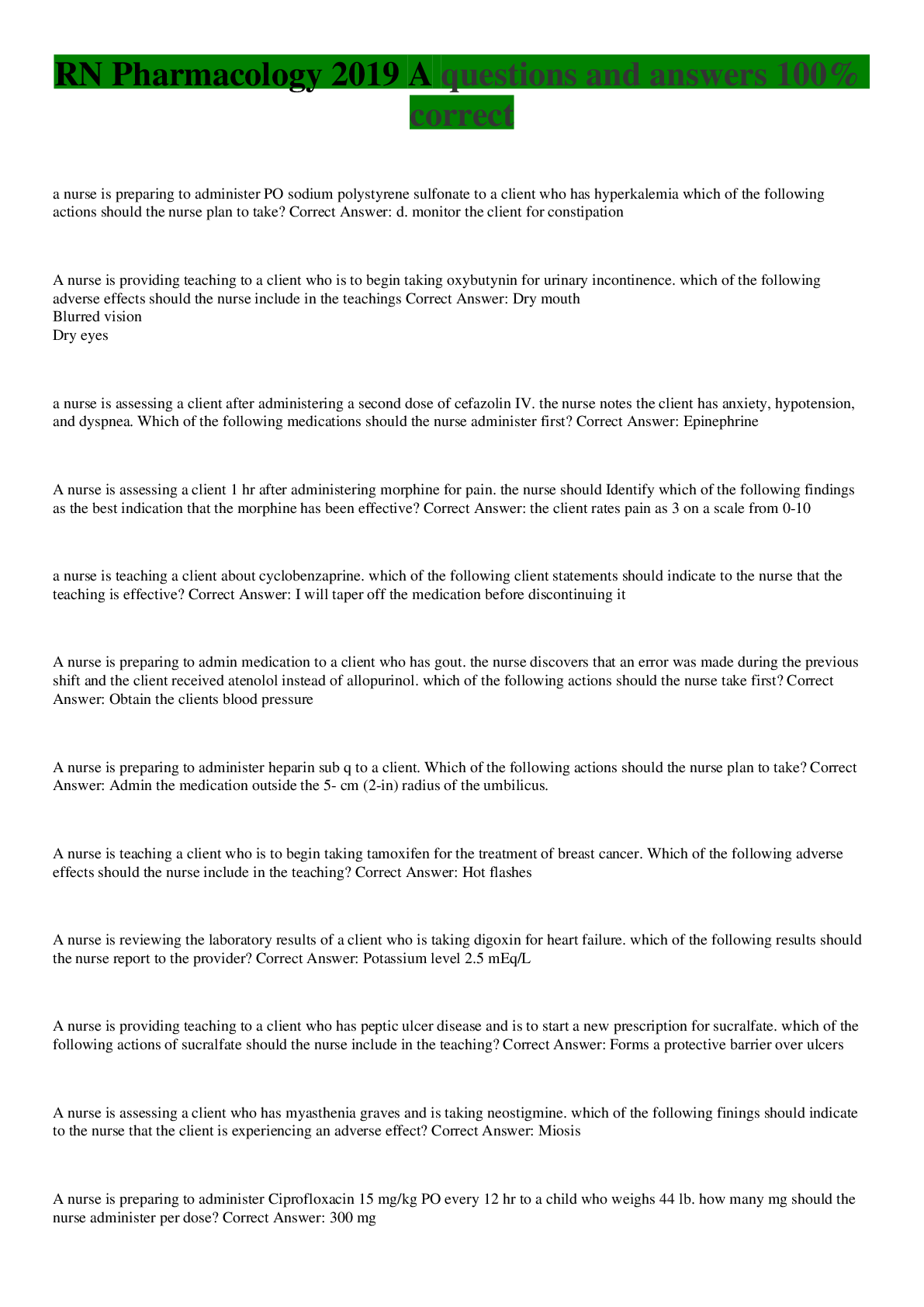
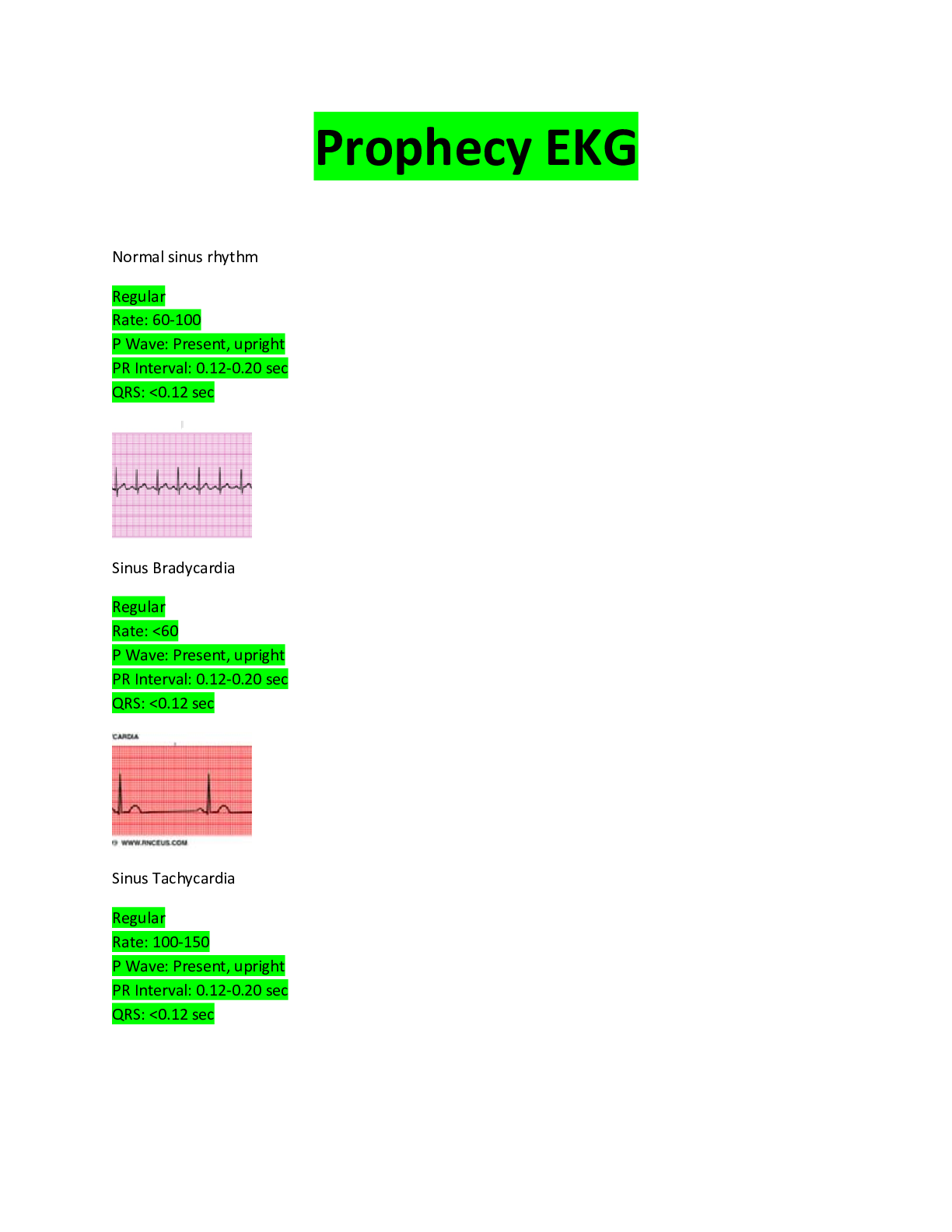




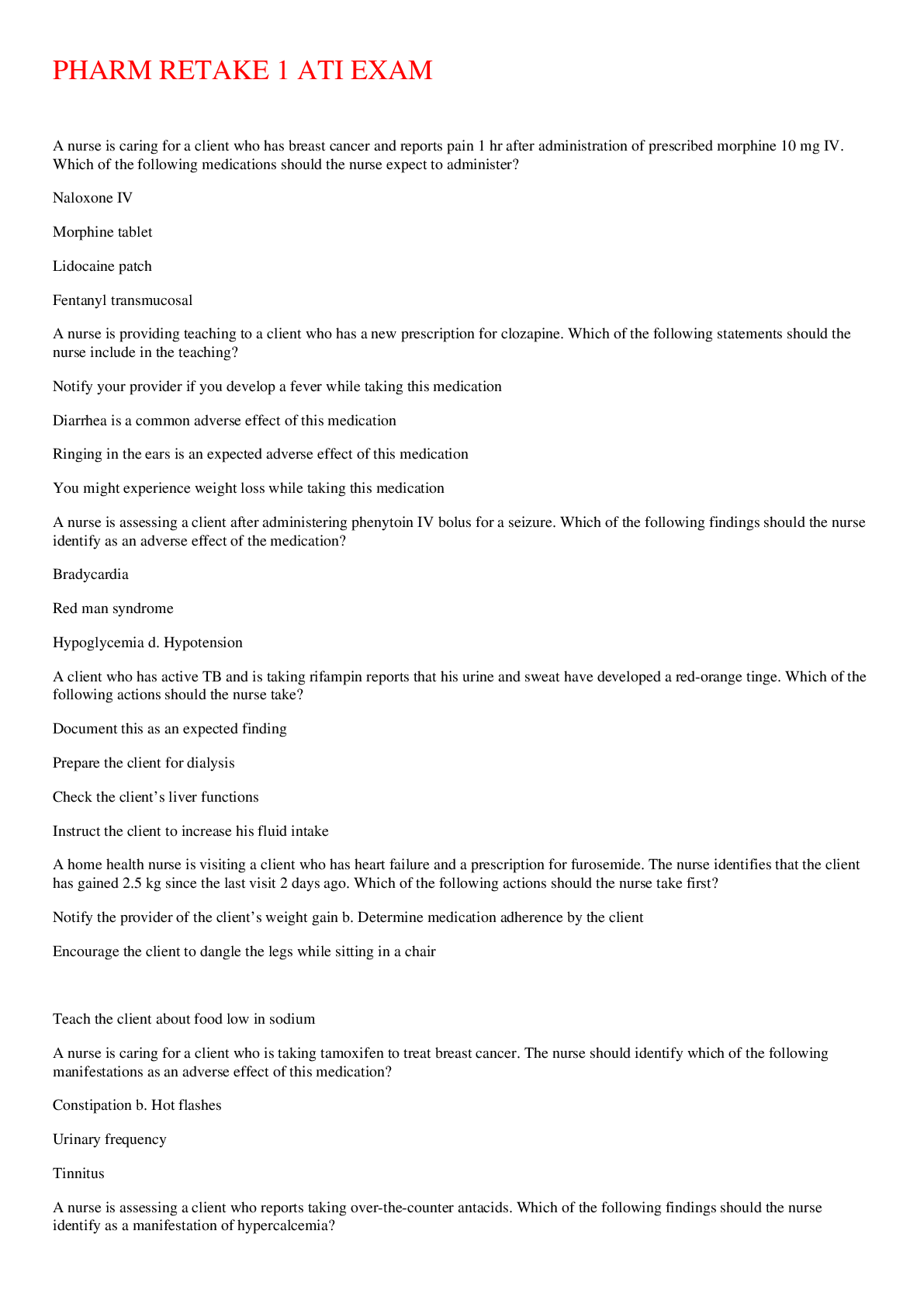
.png)
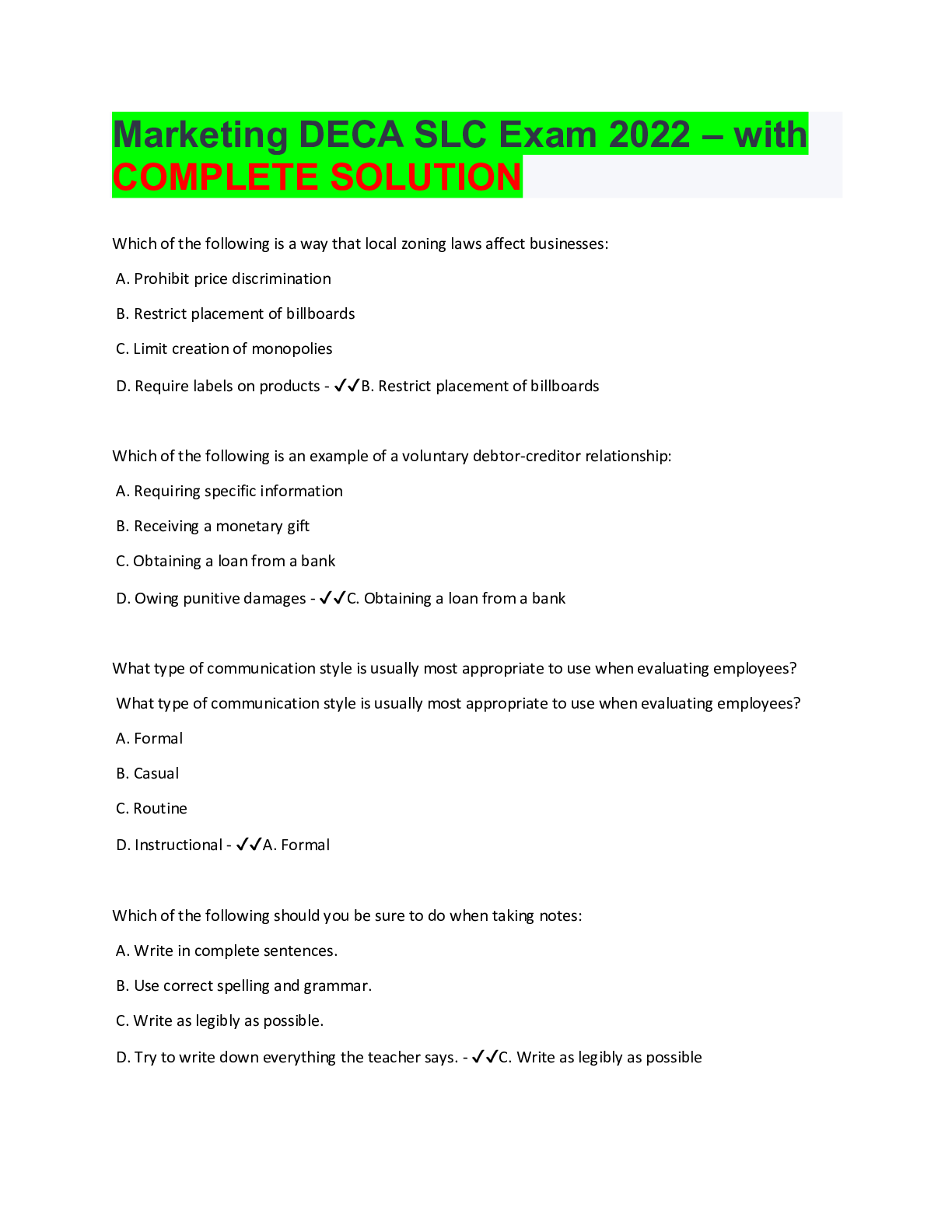

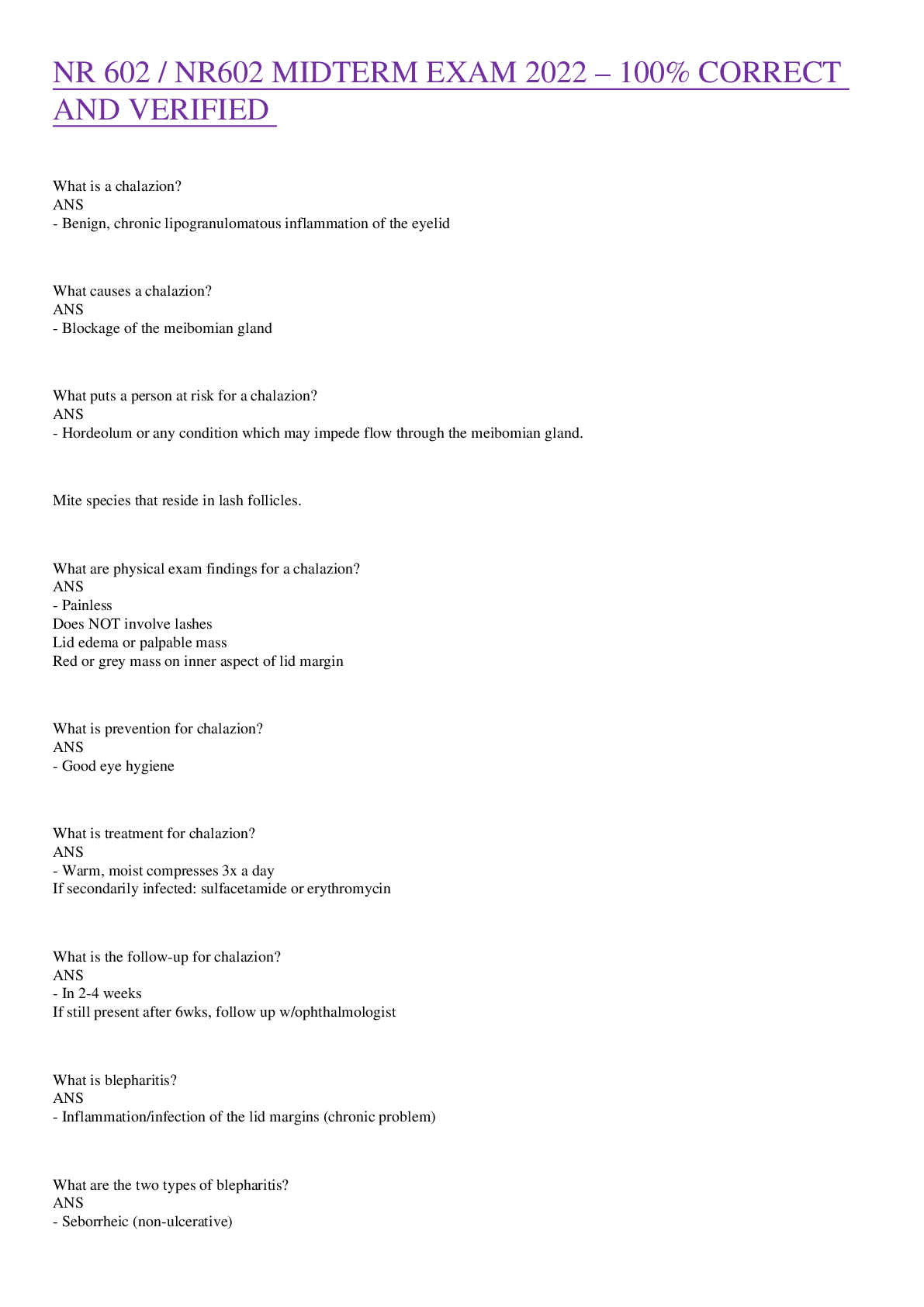


.png)
